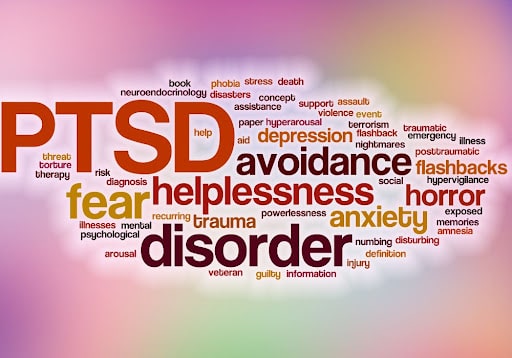Students with PTSD often have a difficult time concentrating on their schoolwork.
If you suspect your child may have PTSD, you should ask for extra help or extra time in class. You can also seek additional treatment options for your child.
The world is still collecting stats about PTSD, and while the research is still ongoing, there are also many types of treatments for PTSD available.
And there are a variety of barriers that may prevent students from getting the treatment they need.
Symptoms of PTSD in Young People and Children
Children can experience PTSD if exposed to a traumatic event at a young age.
Symptoms are different for children of different ages but are often associated with the same trauma. Young children may experience hypervigilance and may become more afraid of strangers.
1. Sleep Problems
Sleep problems are also common in children with PTSD, including difficulty falling or staying asleep. They may also have nightmares and be afraid to sleep alone. They may also experience separation anxiety.
A health practitioner may diagnose PTSD if symptoms persist for over a month. This condition can cause significant distress and impact a person’s work, study, relationships, and day-to-day life.
2. Distress
Children with PTSD may express distress differently, with some reliving the traumatic event through play or having frightening dreams that contain no recognizable content.
They may also become socially isolated and experience extreme temper tantrums.
In addition to the emotional symptoms, children with PTSD may have negative thoughts about the event. They may wonder why it happened and whether they could have prevented it.
3. Avoidance
Another common symptom of PTSD is a person’s tendency to avoid traumatic reminders. This may include avoiding certain places and people and avoiding talking about the trauma.
They may also engage in other activities to distract themselves from the traumatic event.
4. Cognitive Changes
In addition to the physical and psychological symptoms of PTSD, young people can experience various cognitive changes due to the traumatic experience.
These changes can include an increased fear of the traumatic event, avoidance of social situations, and distorted beliefs about oneself.
5. Negative Emotions
PTSD can cause people to develop negative moods and sleep disturbances.
While there are no specific treatments for PTSD, research into the brain and gene changes that cause PTSD is progressing.
The hippocampus and amygdala become overactive in people with PTSD, while the prefrontal cortex – the region responsible for emotion regulation and impulse control – is less active.
This underactive prefrontal cortex causes decreased positive emotions, irritability, and social withdrawal.
Exposure to war has increased the risk of PTSD in children. A meta-analysis of children exposed to wars found that up to 47 percent were affected by PTSD at some point.
Refugees and displaced children are also at increased risk of developing PTSD. Child soldiers have exceptionally high rates of PTSD.
Researchers have also found that children who experience multiple traumatic events are more likely to develop PTSD than children who encounter one traumatic event.
The symptoms of PTSD in young people may be less severe than in adults.
Exposure therapy uses techniques such as mental imagery to help people work through the trauma. Other methods include cognitive restructuring and medication.
Cognitive restructuring involves a person learning to make sense of bad memories. The goal is to help the person see events in a more realistic light.
Treatments of PTSD in Young People and Children
There is a need for effective treatments for young people with PTSD. However, there are many challenges associated with the development of such treatments.
One of the main challenges is the lack of access to services, especially in underserved and rural communities.
A limited number of mental health professionals in such areas may only be trained in one type of therapy. School-based resources are often absent.
The socio-cultural and political climate of a community may also influence whether there is adequate access to these services.
1. Cognitive Behavioral Therapy (CBT)
Cognitive behavioral therapy (CBT) is one of the most effective methods for treating PTSD. It involves engaging the patient in psychoeducation and problem-solving strategies.
This form of therapy aims to help students deal with trauma through a structured process. This therapy is usually administered for twelve to sixteen weeks.
Early detection and treatment of PTSD in children can decrease the severity of symptoms and improve development and quality of life.
An evaluation of the child’s needs and the family’s circumstances will help to make the best treatment recommendations.
Treatments for students with PTSD include psychotherapy and education for the child and the family. In addition, children may benefit from medications to combat symptoms.
The type of exposure to the trauma, intensity, and duration of exposure to the traumatic event all impact the likelihood of a child experiencing PTSD.
In a recent study, seventy-seven percent of children involved in a shooting had moderate to severe symptoms. However, most children who were not directly exposed to the trauma went home.
2. Medications
Several medications for treating children with PTSD, most of which target memory consolidation and physiologic hyperarousal.
The opioid analgesic morphine is commonly prescribed for pain associated with invasive medical procedures and is designed to decrease hyperarousal.
Another common medication is the alpha-agonist clonidine, which is designed to treat symptoms associated with hyperarousal.
Other treatments for children with PTSD include atypical antidepressants. Among these are venlafaxine and imipramine, which have shown promise as treatments for PTSD in a small population.
However, their use has been limited by the risk of cardiovascular side effects. Additionally, patients must follow a restricted diet while taking these medications.
3. Exposure-Based Treatments
Exposure-based treatments are vital for children whose memories of trauma are distressing. These treatments involve gradual exposure, as well as teaching children to learn relaxation techniques.
Eventually, children learn not to be afraid of these memories. Cognitive-behavioral therapy, or CBT, involves challenging children’s false beliefs.
It is safe for children with PTSD and has been shown to reduce symptoms.
Barriers To Accessing Mental Health Services For Students With PTSD
Many barriers prevent students with PTSD from accessing adequate mental health care.
These barriers are most common in low and middle-income countries.
However, some interventions are available to address these issues. In this paper, we explore the most common factors that hinder access to these services.
Barriers to accessing mental health services include:
- Family beliefs.
- Negative beliefs about mental health professionals.
- A lack of cultural sensitivity.
In addition, barriers to accessing services often relate to stigma and lack of knowledge about mental health.
The literature is littered with examples of interventions that have shown promise for overcoming these barriers.
While this may sound disheartening, understanding these factors is the first step in improving access.
One way to do this is by providing effective case management software. With the right case management software, the barriers can be overcome.
Apricot can help health and human services organizations identify these barriers and improve their response.
Currently, minority populations represent a significant portion of the US population and suffer from major mental health disparities.
These individuals have less access to mental health care and poorer quality of care than white individuals. A national effort is needed to address these disparities.
Increasing rates of mental health issues among adolescents are a cause for concern. However, many teens experiencing mental health issues remain reluctant to seek help.
To close this gap, we need to understand better the factors that prevent young people from seeking help. The current literature has identified five barriers and facilitators to help-seeking among adolescents aged 10 to 19.
Final Word
Mental health issues are rising in adolescents and young adults, yet many do not seek help. To close this gap, we need to understand better the factors that prevent young people from seeking help.
The current literature has identified five barriers and facilitators to help-seeking among adolescents aged 10 to 19.
Addressing these barriers is critical in improving access to mental health services for students with PTSD.
Awesome one; I hope this article answers your question.
Editor’s Recommendations:
- Top 5 Best Medical Schools in Ohio (FAQs)
- How to Be a Nurse Practitioner in South Korea (FAQs)
- Internal Medicine Shelf (Meaning, Key Guides, Study tips)
- 10 Best Medical Schools for Pediatrics (Duration, How-to, FAQs)
- 10 Best Medical Schools in the Philippines (How-to, Cost, FAQs)
If you find this article good, please share it with a friend.




